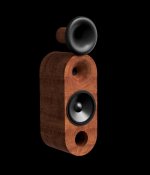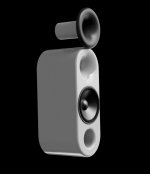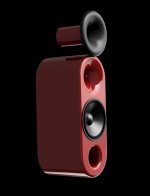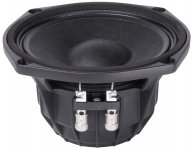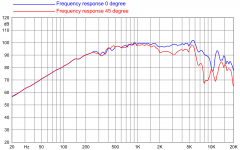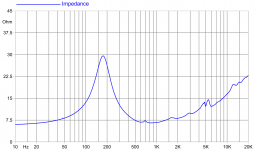Well 6 ms would certainly resolve anything at about 700 Hz. But yes, making acoustic measurements in a small room is always a problem. Even the Klippel system needs a fairly large room. But a "large hall" is hardly required! And ground plane is also not very practical and prone to errors if not done correctly (basically I don't like it.). As far as I can tell my technique works best for small rooms, but even it has its limitations.
Remember that with my technique one can get closer to the source and still get valid far-field data. This helps with the windowing issue. Near field done without doing what I am doing are not going to be correct.
Remember that with my technique one can get closer to the source and still get valid far-field data. This helps with the windowing issue. Near field done without doing what I am doing are not going to be correct.
That's true, that by itself can be an improvement. I didn't think about it this way.Remember that with my technique one can get closer to the source and still get valid far-field data. This helps with the windowing issue. Near field done without doing what I am doing are not going to be correct.
Differnt coverage
Hello,
I am trying to get an 12 inch wide horn (with a depth of about 11-12cm) for 1 inch compression driver. I want to achive a horizontal coverage of about 90 Degrees and a vertical coverage of about 40 degrees (-6db) down to about 1.5khz.
I have seen here that you can use differnt curves for horizontal and vertical curve here:
post6349644
I have now started with the following trying to achive 90/40 pattern but without success.
Can someone help me to get the right values for Coverage.Angle, Term.s, Term.n. Term.q to get 90/40 coverage?
I do not really undestand the math behind that.
Hello,
I am trying to get an 12 inch wide horn (with a depth of about 11-12cm) for 1 inch compression driver. I want to achive a horizontal coverage of about 90 Degrees and a vertical coverage of about 40 degrees (-6db) down to about 1.5khz.
I have seen here that you can use differnt curves for horizontal and vertical curve here:
post6349644
I have now started with the following trying to achive 90/40 pattern but without success.
Code:
Throat.Profile = 1
Throat.Diameter = 25.4 ; [mm]
Throat.Angle = 10.5 ; [deg]
Length = 112 ; [mm]
....
Coverage.Angle = 45 - 27*sin(p)^2
Term.s = 0.7 - 0.2*sin(p)^2
Term.n = 4.0 - 1.45*sin(p)^2
Term.q = 0.996 - 0.002*sin(p)^2Can someone help me to get the right values for Coverage.Angle, Term.s, Term.n. Term.q to get 90/40 coverage?
I do not really undestand the math behind that.

Last edited:
It's a lot easier to use a guiding curve - see GCurve.* (6.4.2 Using guiding curves)
(You can use an ellipse and perhaps morph it to a rectangle.)
(You can use an ellipse and perhaps morph it to a rectangle.)
can you please give me some starting help with some basic config file which goes in the right direction? Sorry I had already a look at the guiding curves (superformula, superellipse) but did not achive what I want. 

I'll have to recall the rectangular shapes and may try something. Maybe to put it in the documentation because these queries start to appear more frequently. Please experiment... This is all pretty time consumig.
Nice, I like the coloured ones with the rounded edge 😉 Rear mount the woofer to finish off the look.Three-ways 🙂
I cant see how you can hope for a lower midrange horn to keep up with a treble WG when they have about the same mouth area?
//
//
Actually, I got some nice results when using the same CD horn for 2" mid driver and for 1" hf driver (with throat extension). When time aligned, the transition was good and room coverage more even.
Well, you get something out of one but it wont be a horn with all its desirable characteristics. You are hoping to bend physical laws which seldom pans out.
//
//
Last edited:
The whole point in using it is to get a similiar (or better) directivity as the woofer would have and at the same time to split the frequency band in two, i.e. to relieve the midrange driver of large excursions.
What do you not believe?
It's the same size as the woofer so the directivities will be very much the same in the range of intended operation. So it will also match the WG, even better above the XO point than the woofer alone. We already know that.
Thinking about downsides, perhaps the only one I can imagine is it will have a (much) smaller voice coil, typically. But the bandwidth will be quite narrow, e.g. 300 - 800 Hz.
It's the same size as the woofer so the directivities will be very much the same in the range of intended operation. So it will also match the WG, even better above the XO point than the woofer alone. We already know that.
Thinking about downsides, perhaps the only one I can imagine is it will have a (much) smaller voice coil, typically. But the bandwidth will be quite narrow, e.g. 300 - 800 Hz.
Last edited:
This is a concept that might work.
I would take a slightly bigger, efficient mid, with Fs < 200Hz, to keep up with the comp. driver.
Something like this (impedance could be cleaner though):
Attachments
Last edited:
In a passive speaker you are typically limited by the sensitivity of the woofer. Reaching around 90 dB/2.83V@m in overall sensitivity of the speaker would be a very good result. So there is really no need for such efficient midrange. It does no harm either but there's no "keeping up" with the CD.
- Home
- Loudspeakers
- Multi-Way
- Acoustic Horn Design – The Easy Way (Ath4)
